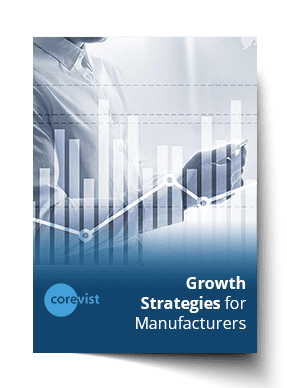Share
Author
George Anderson
Share
First published May 15, 2019. Refreshed Sept 8, 2021.
Thinking of launching a new product line through a new B2B eCommerce channel? You’re not alone. We’ve helped several manufacturers take this approach, and we recommend it wholeheartedly. It forces you to align multiple teams across the organization, and it keeps everyone focused on delivering business value. What’s more, if you don’t have B2B eCommerce in place already, launching a new product this way pushes you to define your go-to-market strategy in the digital age.
In this post, we’ll go over the benefits of using B2B eCommerce as the focal point of your product launch. Then we’ll help you build an intelligent plan to make your new product a win for the business.
Let’s dive in!
The business case: Why B2B eCommerce is the best focal point for a product launch
Historically, manufacturers have launched new products through their existing distribution channels. However, as a new, potentially disruptive distribution channel, B2B eCommerce offers all kinds of benefits which other channels don’t have. Here’s why a web store is the perfect channel for launching a new product:
- It forces alignment across all departments and puts customer value first. While this can be a painful transition internally, it ultimately helps you get back on mission if internal politics have softened your focus on customers.
- It offers a centralized digital landing point (the B2B eCommerce website) where you can point your customers. With one destination for marketing, you get more control over the impression you make with the product.
- It offers a centralized performance dashboard (B2B eCommerce analytics like what Corevist Commerce provides) to see how your new product is performing.
- It can help your R&D team design the next iteration of the product, based on B2B eCommerce data on product performance.
Of course, for your organization to realize these benefits, you’ll have to align on the many facets of launching a new product. Let’s take a look at some of those areas where you need to create alignment.
The challenge: Make sure your product launch plan covers all the bases
Define your new product in SAP
It sounds easy, but getting your new product set up properly in SAP is the #1 hurdle to a successful product launch. Here’s what that means:
- Make sure you establish contract pricing in SAP for the new product, for all customers who will be allowed to buy it. That way, when you launch an SAP-integrated solution like Corevist Commerce, the right pricing displays automatically for each logged-in user.
- Configure the inventory/ATP rules in SAP for the new product. Are you going to show each customer the total inventory available, or will you use an ATP (available to promise) calculation, by customer, to show only the total amount of inventory allocated to that customer? You need to set this up in SAP so a solution like Corevist Commerce can display accurate, personalized inventory availability for each logged-in user.
- Configure the RDD/EDD rules in SAP for the new product. Are you going to let customers specify an RDD (requested delivery date), or are you going to show them an EDD (estimated delivery date)? Whichever one you choose…
- …make sure your logistics are worked out, in SAP and in reality, so you can ship the product immediately when customers start placing orders. You may need to account for geography, available carrier partnerships, minimum freight quantity, and more.
When all of these things are set up properly in SAP, they’ll flow naturally into an SAP-integrated B2B eCommerce solution like Corevist Commerce. Because Corevist is integrated to your SAP system out of the box, you only have to create and maintain those business rules in one place (SAP), and they’ll display in Corevist Commerce automatically, including personalized data like pricing and ATP.
Of course, getting that product off the ground is more than just an SAP checklist. To achieve a strong product launch through a new B2B eCommerce channel, you’ll need to motivate and align people from multiple teams within your organization. Let’s talk about that.
Align your team on the timing and priority level of the product launch
Ultimately, you’ll depend on each member of your team to make this product a success. What will it take from an organizational perspective to make this work? Here are some things to consider:
- Is your IT team aligned with the goals that the business has set for the new product launch? Has IT made it a high priority to get the new product set up in SAP? Are they demonstrably working toward a deadline?
- If you have a marketing or sales team in charge of new product launches, are they informed and ready to use the new B2B eCommerce store as the focal point for all their efforts? Do they have the supporting materials (training, documentation, marketing collateral) that they’ll need to do so?
- Do you have a communications plan to tell existing customers about the new product? This is especially important if the new product is replacing an old one. The first order of business is to inform existing customers of the upgrade (and why they should upgrade). For more on communicating about new products, see this post: Product Lifecycle Transitions In B2B eCommerce.
The Takeaway: Align your team, align your data, and choose SAP-integrated B2B eCommerce
At Corevist, we believe launching a new product through B2B eCommerce should be seamless. If you’re going to invest in creating business rules for the product in SAP, why rebuild those business rules in two additional systems? (That’s what you’ll have to do if your B2B eCommerce solution doesn’t include SAP integration. You’ll have to rebuild that logic in a middleware integration platform and in B2B eCommerce.)
With a real-time SAP integration and no middleware, Corevist Commerce brings your SAP business rules to the web so your logged-in users see accurate personalized pricing, accurate inventory, and more.
NEW Report:
Growth Strategies for Manufacturers
Every manufacturer needs to grow in the digital age. Here’s the ultimate guide to growth strategies for manufacturers. Read now.










